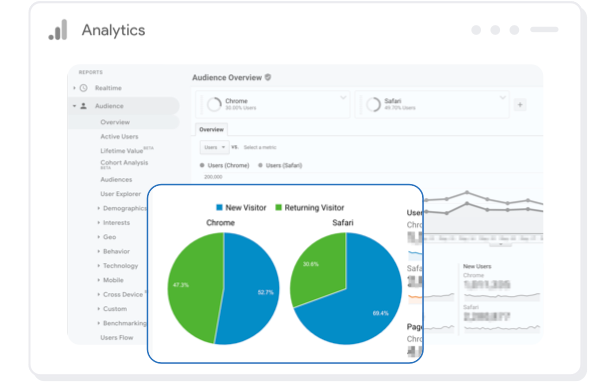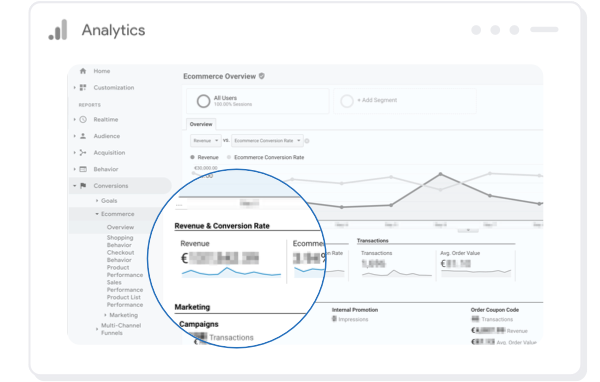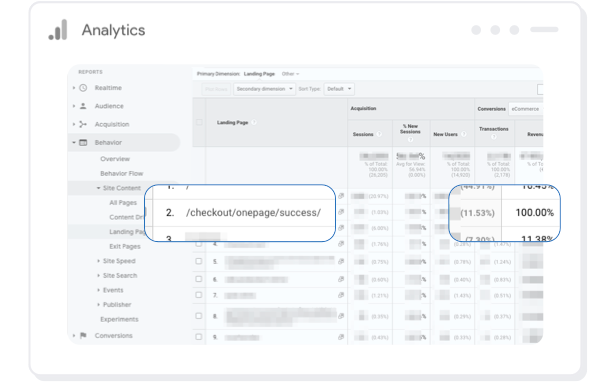However, the current state of analytics means that some eCommerce websites are missing up to 30% of their attribution data. This is due to the increasing use of adblockers and browsers with tracking prevention, post-Brexit data transfer complexities, and the banning of Google Analytics in Austria and France. The reason behind this ban is that Google Analytics stores data from EU residents on cloud servers based in the US. According to the data protection authorities in Austria, this violates the GDPR. This might result in a complete ban of Google Analytics in Europe in the future.
To figure out how much data you are missing due to the current state of analytics, have a look at these three questions:
1. Safari vs. Chrome: What Is the Difference in Returning Visitors?
Since the release of Intelligent Tracking Prevention in 2017, Safari has prevented the ability to track individuals by blocking third-party cookies, fingerprinting, and more. A newer version of Apple’s privacy initiative introduced in 2019 means the storage duration for first-party cookies has been reduced from the usual 90 days to just seven days.

ITP, a required component for any iOS web browser, has created new challenges for eCommerce businesses, which rely on third-party cookies to unify customer journeys and generate data-driven insights about website visitors. For example, by reducing the storage time to just one week, you can no longer map a customer’s journey if they take longer than seven days between one visit to another. This could prove particularly troublesome for certain retailers, such as those selling cars, where the transaction process typically takes longer than one week to complete.
It also makes it more difficult to differentiate between new and returning users. This ultimately means that your user-level metrics are inaccurate, which can lead to issues in segmenting your audience, measuring metrics, and assessing the performance of campaigns.
Google has announced that it will start blocking third-party cookies in 2023, but first-party cookies will continue to function. They will continue to require consent unless the purpose of a cookie is ‘strictly necessary’ to the basic operation of a website. However, this won’t be the case in Denmark and Belgium, where it’s not allowed to run necessary cookies before consent.
To get an estimation of how much data in Safari is not accurate for your website, compare the difference in returning visitors for Chrome versus Safari in Google Analytics:
- Open Audience > Overview
- Add two segments: for Safari and Chrome
- Compare the % new vs. returning visitors
2. Google Analytics vs. Your Backend: How Much Revenue Are You Missing?
Another common problem is that current enhanced e-commerce events often don’t reflect the correct numbers in the backend e-commerce platform due to a mix of tracking prevention and client-side transaction tracking. Think of tracking that enables you to break down each buying process step in detail.

These disparities can result in a large difference between your businesses’ measured transactions and revenue when comparing figures in Google Analytics and what you report in your backend. Ultimately, this means you could be underestimating the revenue attributable to your paid marketing efforts.
To get an estimate of how much revenue you are missing in your Google Analytics:
- Open Conversions > Ecommerce > Overview
- Compare the revenue you report here with your backend
3. What Percentage of Your Transactions Have the ‘Thank You Page’ as the Landing Page?
Currently, many eCommerce websites track their conversions via the ‘Thank you’ page. These pages are important because they offer potential nurture leads and help with customer retention. However, these pages can also result in broken customer journeys and, again, impact how accurately you can attribute revenue generated to your paid marketing efforts.

To get an estimate of how much revenue is incorrectly attributed in your Google Analytics because of broken customer journeys:
- Open Behaviour > Site Content > Landing Pages
- Find your conversion ‘thank you’ page (depends on your website)
- Note the revenue & conversion rate of this page
How TraceDock Can Help
If you’re being met with the challenges described above, TraceDock is here to help. It’s a first-party data collection service that helps eCommerce websites overcome the problem of ad-blocking and tracking prevention, allowing your business to attribute all transactions to the proper channels and campaigns while preserving your consumers’ privacy.
Implementing TraceDock ensures that the percentage of returning visitors between Chrome and Safari will converge. This improves the correct attribution of Safari to your paid marketing efforts. At the same time, it will ensure that you report all revenue in Google Analytics, including the correct attribution to your paid marketing efforts.
What’s more, TraceDock will also make sure that all transactions that seem to originate from the ‘thank you page’ will now be attributed to the correct paid marketing effort.









